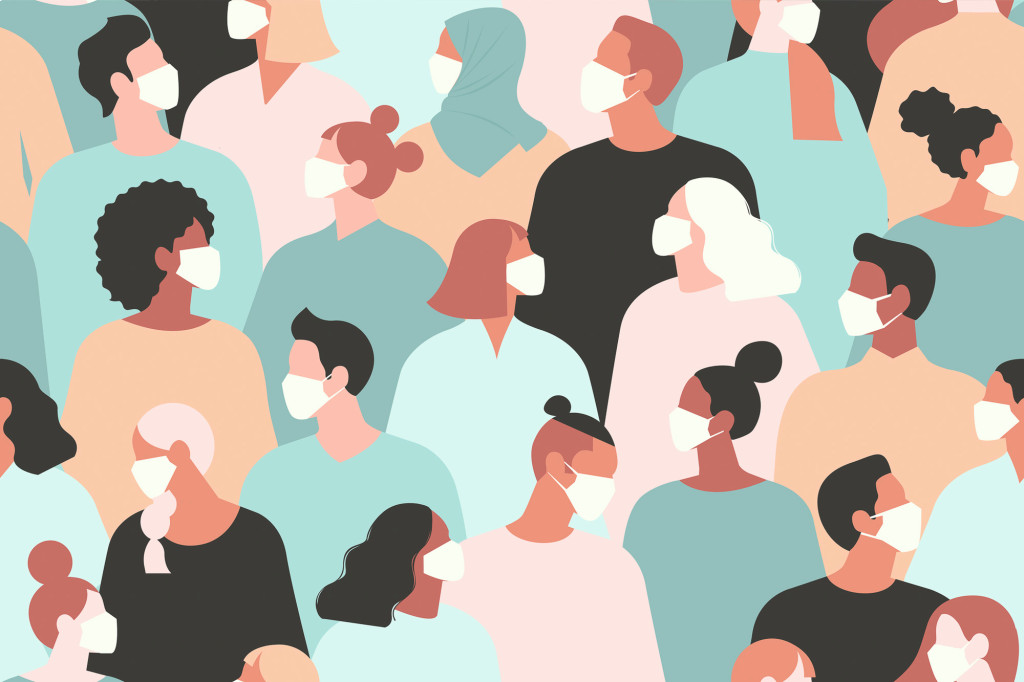
“Our eyes, our pupils, our hands, our gestures … it is our whole body that will be called upon to transmit our emotions when wearing a mask,” says neuropsychologist known with her research on vision and cognition, and psychology of perception.
“Wearing a mask can prevent us from decoding what the facial features radiate,” she says and continues :
To communicate, we need to process the information which is emitted in the triangle formed between the eyes and the mouth. This information we gather from the facial emotions allows us to understand the state and the intention of the person before us. It will even enable us to be empathetic. Whereas deprived of seeing the facial expressions, it will be difficult to know what the person is thinking let alone establishing a solid communication. The eyes are certainly very important, but may be insufficient in accessing the habitual information which would otherwise be possible to gather.
It will therefore be necessary to focus on the lines and movements of the forehead and the eyebrows, as well as the wrinkles around the eyes, when wearing a mask. In addition, if we are to respect one to two meters of social distance, it will become even more difficult to focus on the appearance and to read through the small expressions between the wrinkles of the eyes and the forehead. We would then intuitively search to compensate for the – out of sight facial expressions – by other means like the bodily movements and gestures, posture, and speech intonations.
Highlighting the difficulty of recognizing a real smile behind a mask, she explains :
It is extremely difficult. We can only trace it when the smile transforms into an intonation in the preceding or the following sentence, or by a tilt of the head. Emphasizing the crucial importance of pupils in any communication :Though we are not aware of it, the pupils transmit a lot of information. We do not consciously notice the dilation or the contraction of the pupils of the person we are interacting with. But our the brain analyzes these cues very well, cues which are unconsciously analyzed allow us to clearly interpret the behavior of the other. We have learned that even babies are able to process the size of the pupils of the person interacting with them.
A dilated pupil is generally associated with a much happier and joyful person. We have a lot more confidence in people who have dilated pupils. It is also a signal of sympathy. On the contrary, a contracted pupil reflects a state of fear or anger. We tend to avoid or flee from people who have contracted pupils.
She recounts the consequences for babies seeing only masked faces on the street or when interacting with their families :
This is a real concern because the baby needs to process all of the facial emotions seen in the adult face. Losing sight of these facial emotions is quite confusing for the baby. Therefore, it is better for adults to use a transparent mask when they are in interaction with infants, young children or children under risk. Also, to compensate for wearing a mask, use of intonations, a language completely adapted to the baby, and humming a little bit would be very reassuring for the babies and young children. It is also necessary to take this into consideration for people with hearing disabilities who need to see lip movements in order to understand what is being said.
She provides some tips for masked yet successful social interactions :
We are not going to be all equal when it comes to wearing a mask. On the one hand, some will adapt much better and compensate for the invisibility of facial expressions with other signals collected from the bodily movements and intonations . For others, it will be more difficult to adapt to this communication centered solely on the gaze, especially if they are a little shy or are a little scared by the mask, like children are.
We will have to adapt by saying that we are all subject to the same situation. Anyway, we have no choice. The best way to do this is to forget this mask and to use this ability of our brain to be plastic, to reorganize and to pay attention to details that we are not necessarily paying attention to in everyday life, that is to say, all bodily movements and bodily expressions, and perhaps even the content of speech. Because ultimately, deprived of facial vision, perhaps we can focus deeper on the substance, on the content of the speech that is being conveyed by the other person.
Duygu Bruce
Sylvie Chokron is a neuropsychologist pursuing her research at CNRS, at the same time she is leading the “Vision and Cognition” team at the Rothschild Ophthalmological Foundation and she is a member of the Psychology of Perception research laboratory at University of Paris 5.
Excerpt from the interview made by France Inter on June 1, 2020.







